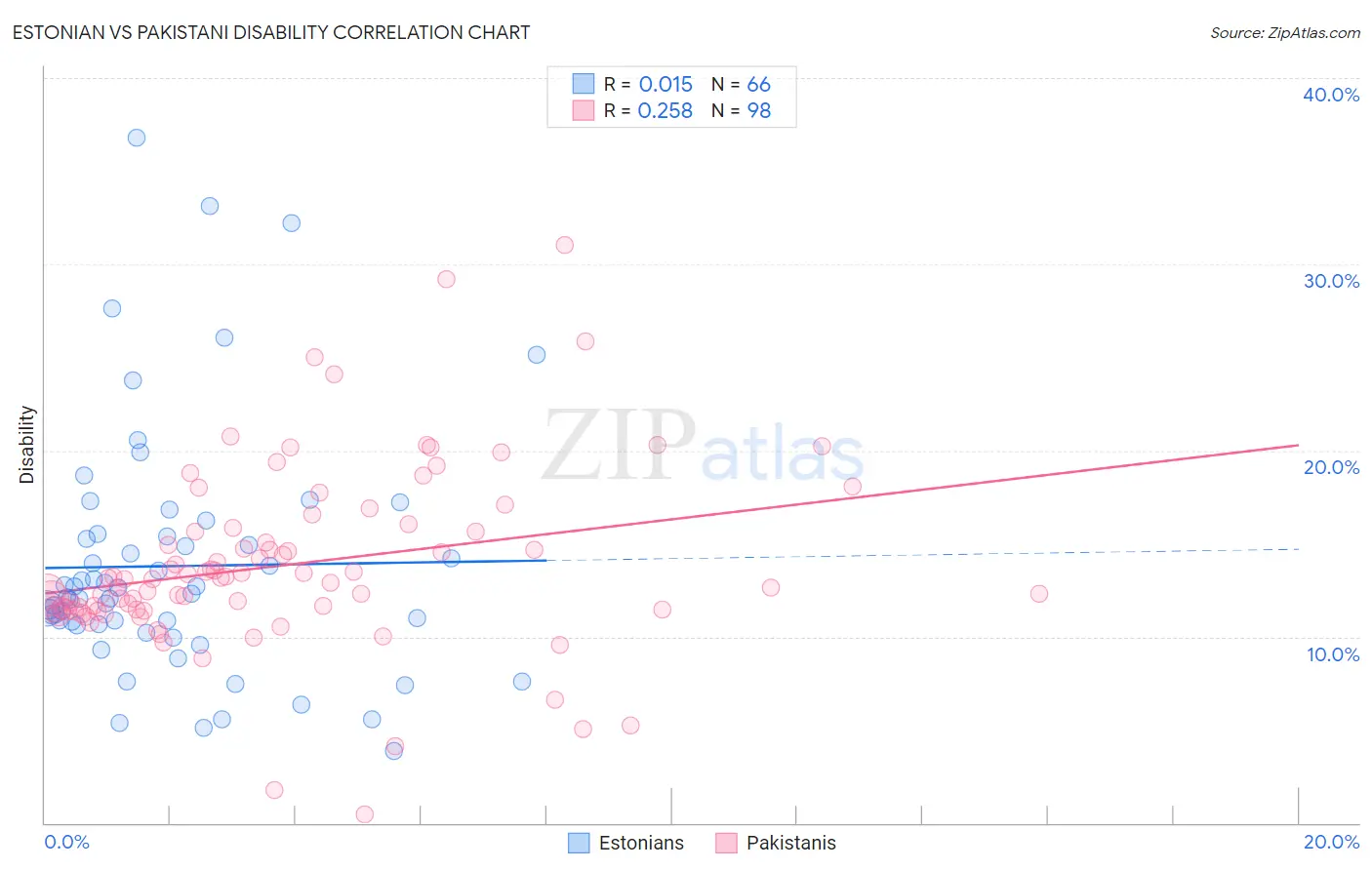Estonian vs Pakistani Disability
COMPARE
Estonian
Pakistani
Disability
Disability Comparison
Estonians
Pakistanis
11.7%
DISABILITY
54.4/ 100
METRIC RATING
167th/ 347
METRIC RANK
11.7%
DISABILITY
54.7/ 100
METRIC RATING
166th/ 347
METRIC RANK
Estonian vs Pakistani Disability Correlation Chart
The statistical analysis conducted on geographies consisting of 123,527,631 people shows no correlation between the proportion of Estonians and percentage of population with a disability in the United States with a correlation coefficient (R) of 0.015 and weighted average of 11.7%. Similarly, the statistical analysis conducted on geographies consisting of 335,302,131 people shows a weak positive correlation between the proportion of Pakistanis and percentage of population with a disability in the United States with a correlation coefficient (R) of 0.258 and weighted average of 11.7%, a difference of 0.010%.

Disability Correlation Summary
| Measurement | Estonian | Pakistani |
| Minimum | 3.8% | 0.46% |
| Maximum | 36.8% | 31.1% |
| Range | 33.0% | 30.6% |
| Mean | 13.8% | 13.9% |
| Median | 12.2% | 13.1% |
| Interquartile 25% (IQ1) | 10.7% | 11.5% |
| Interquartile 75% (IQ3) | 15.4% | 15.7% |
| Interquartile Range (IQR) | 4.8% | 4.2% |
| Standard Deviation (Sample) | 6.6% | 4.9% |
| Standard Deviation (Population) | 6.5% | 4.8% |
Demographics Similar to Estonians and Pakistanis by Disability
In terms of disability, the demographic groups most similar to Estonians are Immigrants from Latin America (11.7%, a difference of 0.020%), Immigrants from Austria (11.7%, a difference of 0.050%), Immigrants from Albania (11.7%, a difference of 0.070%), Immigrants from Southern Europe (11.7%, a difference of 0.070%), and Trinidadian and Tobagonian (11.7%, a difference of 0.080%). Similarly, the demographic groups most similar to Pakistanis are Immigrants from Latin America (11.7%, a difference of 0.030%), Immigrants from Austria (11.7%, a difference of 0.060%), Immigrants from Albania (11.7%, a difference of 0.080%), Cuban (11.7%, a difference of 0.090%), and Immigrants from Southern Europe (11.7%, a difference of 0.090%).
| Demographics | Rating | Rank | Disability |
| Immigrants | Fiji | 69.5 /100 | #156 | Good 11.6% |
| Immigrants | Middle Africa | 69.5 /100 | #157 | Good 11.6% |
| Armenians | 65.9 /100 | #158 | Good 11.6% |
| Guatemalans | 65.1 /100 | #159 | Good 11.6% |
| Immigrants | Barbados | 64.2 /100 | #160 | Good 11.6% |
| Immigrants | Cuba | 62.8 /100 | #161 | Good 11.6% |
| Immigrants | Haiti | 59.2 /100 | #162 | Average 11.7% |
| Immigrants | Trinidad and Tobago | 58.9 /100 | #163 | Average 11.7% |
| Syrians | 58.5 /100 | #164 | Average 11.7% |
| Cubans | 56.7 /100 | #165 | Average 11.7% |
| Pakistanis | 54.7 /100 | #166 | Average 11.7% |
| Estonians | 54.4 /100 | #167 | Average 11.7% |
| Immigrants | Latin America | 54.1 /100 | #168 | Average 11.7% |
| Immigrants | Austria | 53.4 /100 | #169 | Average 11.7% |
| Immigrants | Albania | 52.8 /100 | #170 | Average 11.7% |
| Immigrants | Southern Europe | 52.8 /100 | #171 | Average 11.7% |
| Trinidadians and Tobagonians | 52.7 /100 | #172 | Average 11.7% |
| Maltese | 50.6 /100 | #173 | Average 11.7% |
| Albanians | 50.0 /100 | #174 | Average 11.7% |
| Haitians | 48.6 /100 | #175 | Average 11.7% |
| Immigrants | Western Africa | 47.5 /100 | #176 | Average 11.7% |